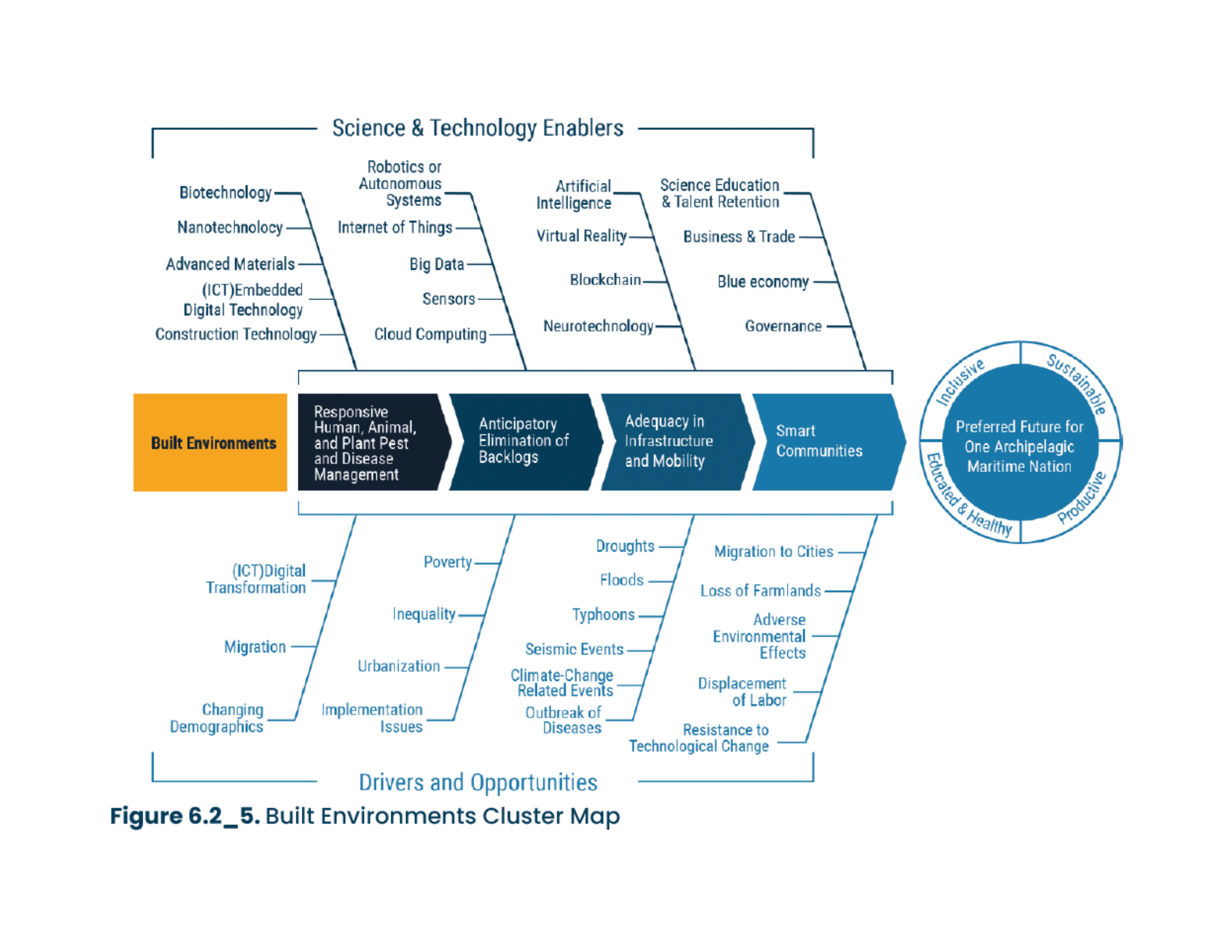INTRODUCTION
The Department of Science and Technology (DOST) has always pushed for the country’s scientific and technological advancement. On the other hand, the National Academy of Science and Technology, Philippines (NAST PHL) has served as primary adviser to government on matters related to science and technology and has actively worked towards developing a truly Filipino productive science culture.
In 2019, DOST Secretary Fortunato T. De La Peña challenged NAST PHL to undertake a foresight study, similar to the Malaysia’s Outlook 2050 crafted by the Akademi Sains Malaysia. The NAST PHL’s proposal to develop a 30-year STI Foresight, including strategic plans, was quickly approved for funding by the DOST Executive Committee the following year. The NAST PHL was able to complete the first and second versions of the country’s STI Foresight document, aptly entitled PAGTANAW 2050, or LOOKING AHEAD 2050, despite the technical and other unprecedented difficulties brought about by the COVID-19 pandemic.
PAGTANAW 2050 is the first DOST-funded inter-disciplinal and trans-disciplinal project on Philippine-focused STI Foresight and Strategic Plan that will impact on the aspirations of the Filipino people by 2050. It is a compendium of STI megatrends, global and national societal goals, transdisciplinary, and interdisciplinary operational areas, and current and emerging technologies relevant to the nation’s development that is firmly grounded in the Filipino people’s aspirations within the context of the natural and physical endowments as well as shared Filipino values and skills, and other potentials.
The said document also delves into probable and significant drivers of change, and provides insights and reflections on the plausible development paths towards achieving the Filipino aspirations as expressed in the 1987 Philippine Constitution, the various Philippine Development Plans, the United Nations Sustainable Development Goals (SDGs), the Department of Science and Technology Harmonized National Research and Development Agenda, and the National Economic Development Authority’s vision for the Filipino people, AmBisyon Natin 2040 (NEDA, 2016).
At the core of this Foresight are 12 key operational areas, namely: Blue Economy; Governance; Business and Trade; Digital Transformation and Information and Communications Technology; Science Education and Talent Retention; Food Security and Nutrition; Health Systems; Energy; Water; Environment and Climate Change; Shelter, Transportation, and Other Infrastructure; and Space Exploration. It is hoped that the S&T aspirations of the Filipino people will be achieved by 2050 through this Foresight.
Executive Summary
At the initiative and leadership of DOST Secretary Fortunato T. de la Pena and as commissioned by the Department of Science and Technology, PAGTANAW 2050 which literally translates to “looking ahead” is the first inter-disciplinal and trans-disciplinal project on Philippine-focused Science, Technology, and Innovation (STI) Foresight and Strategic Plan. The main goal of the Foresight document is to chart a strategic path by anticipating the factors that will influence the development of the Philippines’ scientific capital in the years leading up to 2050. It is meant to serve as a planning device towards achieving concrete goals and designing strategic plans that shall transcend political periods whilst aiming for inclusive growth, sustainability, and competitiveness in STI. The document also suggests significant drivers of change and provides insights and reflections on plausible STI development paths that will impact on the aspirations of the Filipino people and development of the nation towards 2050.
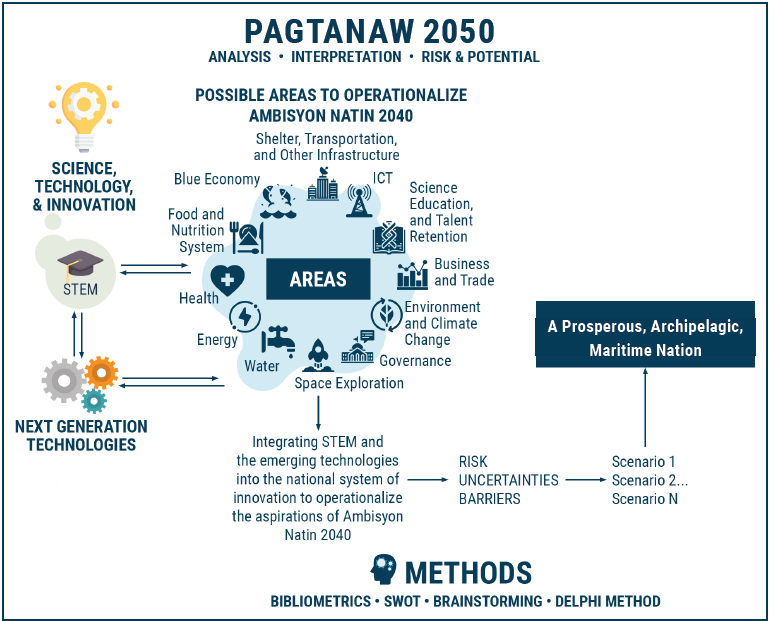
Section 1 - The Making of the 30-Year Science, Technology, and Innovation Foresight and Strategic Plan
This framework builds on aspirations and initiatives expressed in the 1987 Philippine Constitution, the past and present Philippine Development Plans, the United Nations (UN) Sustainable Development Goals (SDG) 2015–2030, the Department of Science and Technology (DOST) Harmonized National Research and Development Agenda, and AmBisyon Natin 2040. Further adjustments have been made in the wake of the COVID-19 pandemic and its impact on the nation’s socioeconomic and political condition.
This framework builds on aspirations and initiatives expressed in the 1987 Philippine Constitution, the past and present Philippine Development Plans, the United Nations (UN) Sustainable Development Goals (SDG) 2015–2030, the Department of Science and Technology (DOST) Harmonized National Research and Development Agenda, and AmBisyon Natin 2040. Further adjustments have been made in the wake of the COVID-19 pandemic and its impact on the nation’s socioeconomic and political condition.
Section 2 - Megatrends: From COVID-19 to Space and Beyond
The demographic profile of the world has changed tremendously over the past three decades, as total fertility has declined and as life expectancy has risen. Migration, both internal and international, has also expanded due to labor shortages, whether in highly-developed urban areas or in advanced countries, and, more broadly, as a response to existing inequalities in incomes and economic opportunities across places.
The demographic profile of the world has changed tremendously over the past three decades, as total fertility has declined and as life expectancy has risen. Migration, both internal and international, has also expanded due to labor shortages, whether in highly-developed urban areas or in advanced countries, and, more broadly, as a response to existing inequalities in incomes and economic opportunities across places.
Section 3 - Setting Sights on the Future: Philippine Goals and Aspirations
The United Nations (UN) General Assembly in 2015 decided to adopt 17 Sustainable Development Goals (SDGs) intended for global achievement by 2030. These were born from the eight Millennium Development Goals that aimed primarily to “halving the world’s extreme poverty rates, stopping the spread of HIV/AIDS and providing universal primary education.” In 2019, the NAST PHL through the leadership of National Scientist Lourdes Cruz sought to align with the SDGs by developing the Future Earth Philippines Project—now being proposed to be expanded into the Future Earth Philippines Platform (FEPP).
The United Nations (UN) General Assembly in 2015 decided to adopt 17 Sustainable Development Goals (SDGs) intended for global achievement by 2030. These were born from the eight Millennium Development Goals that aimed primarily to “halving the world’s extreme poverty rates, stopping the spread of HIV/AIDS and providing universal primary education.” In 2019, the NAST PHL through the leadership of National Scientist Lourdes Cruz sought to align with the SDGs by developing the Future Earth Philippines Project—now being proposed to be expanded into the Future Earth Philippines Platform (FEPP).
Section 4 - Facets of Philippine Science, Technology, and Innovation
At the core of this Foresight are 12 key operational areas, outlined below, which can enable the realization of our societal aspirations through a unified STI agenda:
At the core of this Foresight are 12 key operational areas, outlined below, which can enable the realization of our societal aspirations through a unified STI agenda:
Section 4.1 – Blue Economy
The “Blue Economy” is an overarching operational area that highlights the Philippines’ inherently archipelagic nature and resources, pointing towards the sustainable use of marine resources—living and non-living—for the improvement of people’s livelihoods while preserving the overall health of our marine ecosystems.
The “Blue Economy” is an overarching operational area that highlights the Philippines’ inherently archipelagic nature and resources, pointing towards the sustainable use of marine resources—living and non-living—for the improvement of people’s livelihoods while preserving the overall health of our marine ecosystems.
Section 4.2 – Governance
Having effective and well-governed institutions are essential to establishing an environment of high rates of investment and improved workforce performance in both the public and private sectors. Strategic technologies can be harnessed for both the government and private sectors to provide quality services, minimize human errors, reduce unreasonable bureaucratic procedures and unnecessary expense, and ultimately achieve administrative efficiency and timely response.
Having effective and well-governed institutions are essential to establishing an environment of high rates of investment and improved workforce performance in both the public and private sectors. Strategic technologies can be harnessed for both the government and private sectors to provide quality services, minimize human errors, reduce unreasonable bureaucratic procedures and unnecessary expense, and ultimately achieve administrative efficiency and timely response.
Section 4.3 - Business and Trade
The Philippines has yet to establish a track record of translating scientific research into commercial products, the prospects can be improved dramatically by considering the business community’s fundamental capacity as both beneficiary and enabler of innovation. In particular, the Philippines should provide a level playing field for our agriculture, industry and service sectors whose processes are especially friendly to innovation and research and development (R&D). However, this will not happen if the high cost of doing business—which includes the cost of energy—stemming from the poverty of public goods is allowed to persist.
The Philippines has yet to establish a track record of translating scientific research into commercial products, the prospects can be improved dramatically by considering the business community’s fundamental capacity as both beneficiary and enabler of innovation. In particular, the Philippines should provide a level playing field for our agriculture, industry and service sectors whose processes are especially friendly to innovation and research and development (R&D). However, this will not happen if the high cost of doing business—which includes the cost of energy—stemming from the poverty of public goods is allowed to persist.
Section 4.4 - Digital Technology/ Information and Communications Technology
In this key operational area, information and communications technology (ICT) is seen as a linchpin for achieving proficiency in STI in the Philippines. The full realization of the benefits of ICT will necessitate a shift towards a robust and accessible Digital Ecosystem, in which Digitally Transformed entities interact with each other, mutually benefit each other, and promote the greater good. Technologies like blockchain, cognitive systems, robotics, and quantum computing including last-mile connectivity to serve users in rural and remote areas are required of this ecosystem.
In this key operational area, information and communications technology (ICT) is seen as a linchpin for achieving proficiency in STI in the Philippines. The full realization of the benefits of ICT will necessitate a shift towards a robust and accessible Digital Ecosystem, in which Digitally Transformed entities interact with each other, mutually benefit each other, and promote the greater good. Technologies like blockchain, cognitive systems, robotics, and quantum computing including last-mile connectivity to serve users in rural and remote areas are required of this ecosystem.
Section 4.5 - Science Education and Talent Retention
The importance of the Science, Technology, Engineering, and Mathematics (STEM) system of education in producing competitive STEM talent in the Philippines is vital in enhancing, maintaining, and monitoring the knowledge infrastructure in STEM. We need to adopt new out-of-the-box pedagogies that emphasize learning by doing.
The importance of the Science, Technology, Engineering, and Mathematics (STEM) system of education in producing competitive STEM talent in the Philippines is vital in enhancing, maintaining, and monitoring the knowledge infrastructure in STEM. We need to adopt new out-of-the-box pedagogies that emphasize learning by doing.
Section 4.6 - Food Security and Nutrition
This operational area highlights the ability of agriculture to increase and diversify production towards the improved nutritional status of the population through new and science-based food system paradigms. In order to achieve desired nutritional outcomes, a sustainable food system should be characterized by green and inclusive growth, economic and social progress, and resilience to multiple risks.
This operational area highlights the ability of agriculture to increase and diversify production towards the improved nutritional status of the population through new and science-based food system paradigms. In order to achieve desired nutritional outcomes, a sustainable food system should be characterized by green and inclusive growth, economic and social progress, and resilience to multiple risks.
Section 4.7 - Health System
Foresighting the Philippines’ health, STI is anchored in achieving an efficiently working and properly funded Universal Health Care Program, which addresses needs that are real, palpable, and which immediately improve human lives. At the moment of writing this Foresight, the Philippines Response is focused towards managing the COVID-19 pandemic. Many of the health system technologies accelerated by the pandemic are quite useful for strengthening the healthcare delivery system.
Section 4.8 – Energy
Section 4.8 – Energy
Since the Philippines is dependent on imported fossil fuel for its energy needs and the energy sector is among the major contributors to greenhouse gas emissions and climate change, it is essential for the country to transition to clean and affordable energy technologies to meet future needs. Priority should be given to solar, wind, and ocean waves energy systems, energy storage, smart grids and networks, biofuels, and energy from wastes.
Section 4.9 – Water
Water resources, water uses, and regional water quality, demand and supply in the Philippines must be managed with regard to their use for domestic water supply, irrigation, flood control, power generation, and pollution control. Clean technologies will be adopted to improve the delivery of affordable clean water, minimize or prevent the production of wastewater effluents, and reduce the cost of water and wastewater treatment.
Section 4.10 – Environment and Climate Change
The Philippines is a hazard prone country and periodically suffers from extreme weather conditions, earthquakes, volcano eruptions, and other natural hazards. It is also one of the countries that are most vulnerable and at risk to climate change. Consistent with Goal 13 of the United Nations' Sustainable Development Goals, the Philippines must adopt global and local actions to combat climate change and manage its impacts by strengthening resilience and adaptive capacity to climate-related hazards and other natural hazards.
Section 4.11 - Shelter, Transportation, and Infrastructure
Secure shelter and good transport facilities are minimum basic needs that are fundamental to what Filipinos aspire for as “maginhawang buhay” (comfortable life) and “panatag na buhay” (secure life), as discussed in AmBisyon Natin 2040 and which still remains relevant within the extended 30-year timeframe of the Foresight. Considering the archipelagic setting and maritime nature of the country, the national aspiration to balance urban and rural development can only be achieved through the improvement of ports, roll-on-roll-off facilities, expressway and road networks, and public transport, coupled with a strategic combination of various water, land, and air transportation modes. Shelter is needed in different forms as residence, refuge, and building as a vital component in organizing smart communities in both urban and rural settings.
Section 4.12 – Space Exploration
Space-based technologies have important applications in communications, weather forecasting, disaster management, natural resources and land use management, and in monitoring the environment. Current upstream and downstream space initiatives and future plans on space technologies must continue to be enhanced.
Section 5 - Uncertainties, Risks, Shocks, and Black Swans
The operational areas identified in this Foresight are intended to enable the realization of the aspirations of the Filipino people towards a state of wellbeing. Various approaches and particular technologies have been identified for this 30-year journey towards inclusive and equitable development. This section identifies the uncertainties, risks, and shocks that may arise during the implementation of the science, technology, and innovation (STI) inputs for the national development agenda, intended to benefit 144 million Filipinos by the year 2050.
The operational areas identified in this Foresight are intended to enable the realization of the aspirations of the Filipino people towards a state of wellbeing. Various approaches and particular technologies have been identified for this 30-year journey towards inclusive and equitable development. This section identifies the uncertainties, risks, and shocks that may arise during the implementation of the science, technology, and innovation (STI) inputs for the national development agenda, intended to benefit 144 million Filipinos by the year 2050.
Section 6 - A Roadmap to the Future
This Science, Technology, and Innovation (STI) Foresight culminates with the STI Roadmap that reiterates cluster goals for the preferred future, science, and technology (S&T) enablers, drivers, and opportunities. The roadmap is a product of numerous National Academy of Science and Technology activities, including technology forecasting, Delphi survey, virtual workshop on the scenario planning, focus group discussions, technology mapping, and iterations with the NAST Foresight Steering Committee.
This Science, Technology, and Innovation (STI) Foresight culminates with the STI Roadmap that reiterates cluster goals for the preferred future, science, and technology (S&T) enablers, drivers, and opportunities. The roadmap is a product of numerous National Academy of Science and Technology activities, including technology forecasting, Delphi survey, virtual workshop on the scenario planning, focus group discussions, technology mapping, and iterations with the NAST Foresight Steering Committee.
Section 7 - Ensuring Continuity and Relevance
Foresight as a long-term policy instrument merits regular review and updating if it is to remain relevant to the times. The foresight process involves intense iterative phases of open reflection, networking, consultation, and discussion leading to the joint refining of future visions and the common ownership of strategies, with the aim of exploiting long-term opportunities opened up through the impact of science, technology, and innovation (STI) on society. It is the discovery of a common space for open thinking on the future and the incubation of strategic approaches. In this sense the foresight process has no beginning or end, since it builds on previous and ongoing conversations and consultations and sets in motion learning curves and other intangible spin-offs which are not easily captured in short timeframes.
Foresight as a long-term policy instrument merits regular review and updating if it is to remain relevant to the times. The foresight process involves intense iterative phases of open reflection, networking, consultation, and discussion leading to the joint refining of future visions and the common ownership of strategies, with the aim of exploiting long-term opportunities opened up through the impact of science, technology, and innovation (STI) on society. It is the discovery of a common space for open thinking on the future and the incubation of strategic approaches. In this sense the foresight process has no beginning or end, since it builds on previous and ongoing conversations and consultations and sets in motion learning curves and other intangible spin-offs which are not easily captured in short timeframes.
STRATEGIC ROADMAPS
This Science, Technology, and Innovation (STI) Foresight culminates with the STI Roadmap that reiterates cluster goals for the preferred future, science, and technology (S&T) enablers, drivers, and opportunities. The roadmap is a product of numerous National Academy of Science and Technology activities, including technology forecasting (Salvacion 2020), Delphi survey, virtual workshop on the scenario planning, focus group discussions, technology mapping, and iterations with the NAST Foresight Steering Committee.
The goal of the STI Roadmap is for the Philippines to eventually become a Prosperous, Archipelagic, Maritime Nation characterized by a society that is inclusive, productive, sustainable, educated, and healthy. Due to uncertainties, risks, and shocks, including the black swans, that may occur within the 30-year period of this foresight, no fixed timelines have been indicated for the four innovation phases. The pace of development may differ among the four clusters.
The integrated map, cognizant of the impact of the COVID-19 pandemic, combines all the clusters and their respective goals, from responsive human, animal and plant pests and disease management to a competitive economy. The progress of each cluster is determined by the interplay of S&T enablers and drivers and opportunities. Achievement of a competitive economy across clusters would bring the Philippines to its preferred future for a prosperous, archipelagic maritime nation that supports a technology-explicit development agenda that is inclusive and sustainable and nurtures a citizenry that is educated, healthy, and productive.
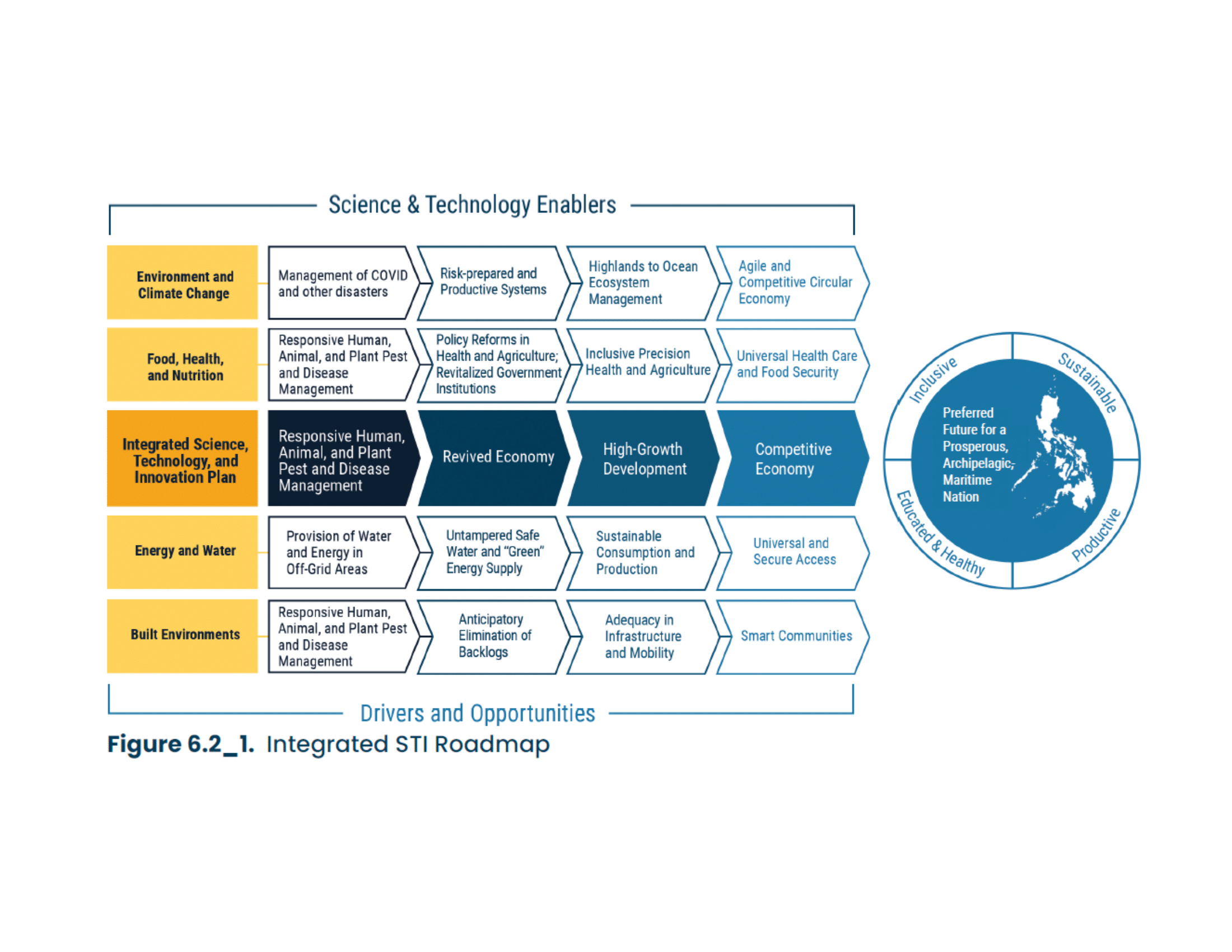
Environment, Climate Change, and Space Exploration Cluster Road Map
For the Environment and Climate Change cluster, the initial goal for the recovery period is to effectively manage COVID-19 and other pests and diseases including those that affect food crops, livestock, poultry, and fisheries. This is necessary for the cluster to achieve an agile and competitive circular economy. It is anticipated that the act of balancing between development and protection of the environment/resources will become more challenging as more people compete for survival, livelihood, and economic gains.
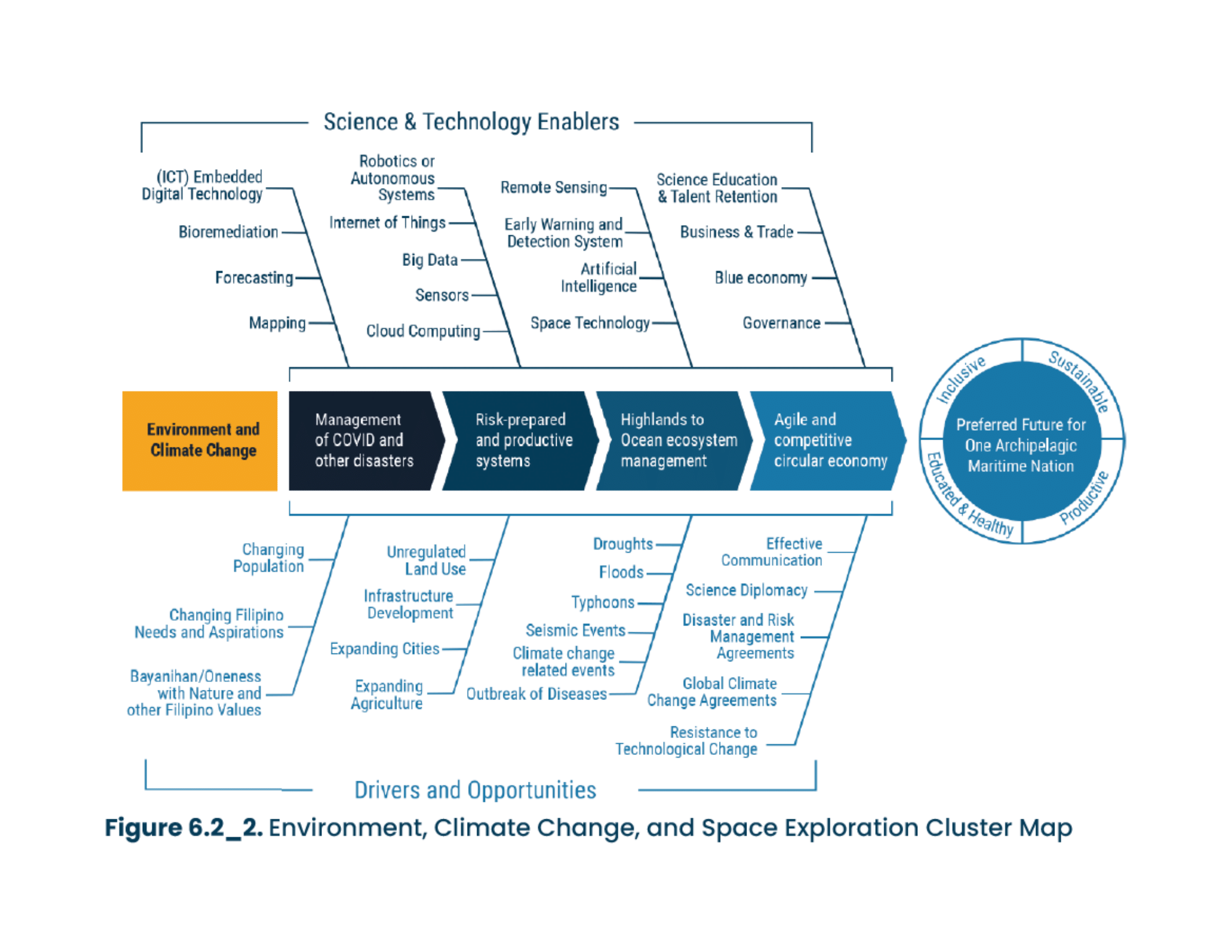
Food, Nutrition, and Health Cluster Road Map
For the Food, Nutrition, and Health Cluster, the initial goal is similar to the Environment, Climate Change, and Space Exploration and the Built Environments clusters. This is followed by policy reforms in health and agriculture, revitalized government institutions, inclusive precision health and agriculture, and universal health care and food security.
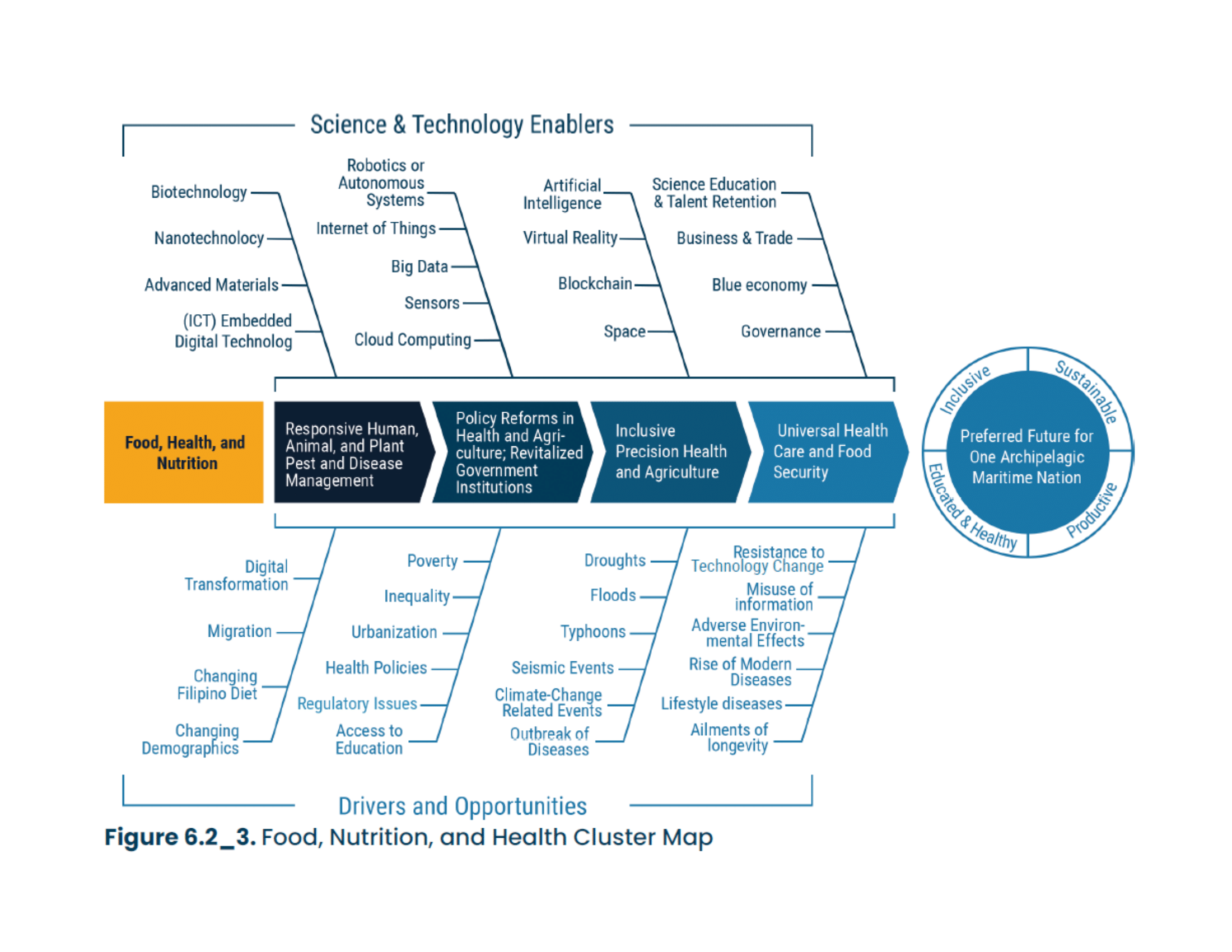
Energy and Water Cluster Road Map
The recovery stage from the pandemic of the Energy and Water cluster aims for the provision of water and energy in off-grid areas. Risks from other natural and man-made disasters should be managed responsibly at this stage. By the second stage, unhampered supply of safe water and energy should be achieved. These resources should be calculated and maintained based on island or regional space planning and implementation. This is critical for transition to the next stage. The third stage, “Sustainable Consumption and Production” builds on the gains of the first two stages through the RDIs for effective clean technologies for water and energy sourcing, storage, and distribution. In this stage, reliance on water and energy supply should consider cybersecurity since these technologies and processes will need ICT and IoT. The fourth stage is geared towards “Universal Access and Security” scenario that can be reached when the drivers and opportunities unique to the cluster are managed harmoniously.
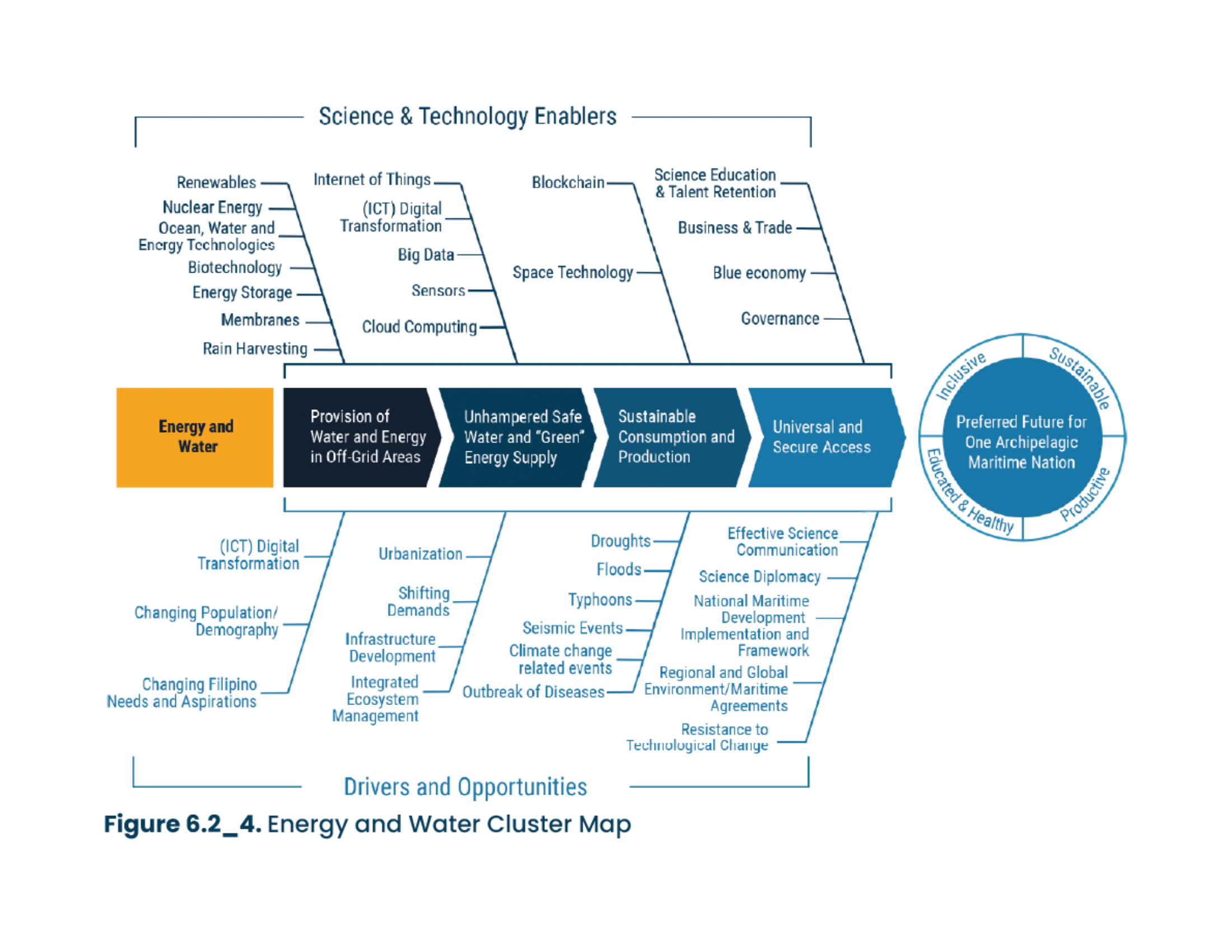
Built Environments Cluster Road Map
The initial setting of the Built Environments cluster is the COVID-19 pandemic that has caused widespread suffering in all sectors and in all countries and exposed in a more pronounced manner, the weaknesses, and inequalities that have been lurking in our midst for many decades.
The challenge is for STI to provide the tools to responsibly manage the incidence of pests and diseases in humans, livestock, and poultry and in the food crops. The containment of the spread of these diseases should set the stage for the revival of the economy, followed by improvements in productivity to create new wealth in a sustainable manner. However, the water and power provision will be discussed in the scenario on water and energy.
